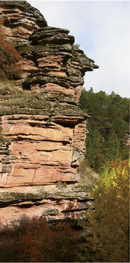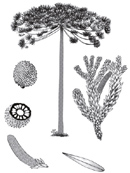
Campus Moncloa
Campus of International Excellence
Triassic
252-201 M.a.


Triassic red sandstones in the Alto Tajo Natural Park (Guadalajara, Spain)

Araucaria angustifolia (Gymnosperm)
The enormous size of Pangaea makes it unstable and it begins to fragment. Fracture zones are created that cause depressed areas. These are occupied by rivers (gravel and sand), by sea (limestone) or salt marshes (clays and gypsum).
Life slowly recovers from the great Permian extinction: modern coral reefs appear in the seas, conifers and ferns dominate the land. Reptiles diversify: crocodiles, turtles and the first aquatic and flying reptiles appear. The first dinosaurs also appear; they are small at first, but quickly reach large sizes. Almost simultaneously early mouse-size mammals appear. The Triassic also ends with an extinction related to a new period of massive volcanism causing the disappearance of large herbivorous reptiles and many groups of marine fauna among others.
| Hadean | ~4600-4000 M.a. |
| Archean | 4000-2500 M.a. |
| Proterozoic | 2500-541 M.a. |
| Cambrian | 541-485 M.a. |
| Ordovician | 485-443 M.a. |
| Silurian | 443-419 M.a. |
| Devonian | 419-359 M.a. |
| Carboniferous | 359-299 M.a. |
| Permian | 299-252 M.a. |
| Triassic | 252-201 M.a. |
| Jurassic | 201-145 M.a. |
| Cretaceous | 145-66 M.a. |
| Paleogene | 66-23 M.a. |
| Neogene | 23-2,6 M.a. |
| Quaternary | 2,6 M.a.-act. |
